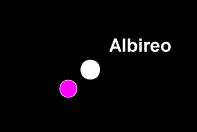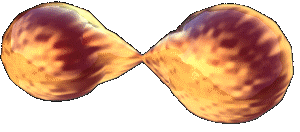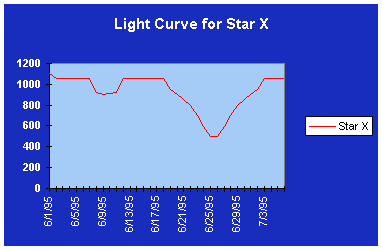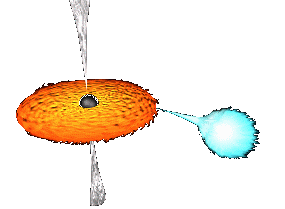![]()
Binary
Stars
By Don Ware
![]()
![]()
![]()
Looking
through a telescope at the stars there is very little information we can
gain from them. To be sure, we know what color they are and we can see
that some are more luminous than others.
If we use a spectrograph we can
tell what elements they are made up from. From these facts alone, it is
difficult to tell just how much mass they
contain.
By looking at pairs of stars that orbit one another we can try to answer the question, how much mass do the stars have?
Binary stars can be of two fundamental types:

Alberio (Visual Binary)
Visual Binaries are stars that are clearly gravitational associated with one another. They orbit each other around a common center called the barycenter. Visual binaries can be seen optically through a telescope. Only a small portion of binary stars are visual binaries. In order to see a visual binary, the stars must be separated by fairly wide distances, and the orbital periods are usually very long.
Optical Doubles are stars that appear to lie close together, but in fact do not, they only appear to us from our earthly observation to be close together. One of the stars in the pair is actually behind the first star and very far away. The stars of an optical double are not gravitationally bound.
William Herschel began looking for optical doubles in 1782 with the hope that he would find a measurable parallax, by comparing a close star to the more distant star in an optical double.
Herschel did not find any optical binaries, but he did catalog hundreds of visual binaries. In 1804 Herschel had so many measurements of visual binaries that he concluded that a pair of stars known as Castor were orbiting one another. This was an important discovery, because it was the first time observational evidence clearly showed two objects in orbit around each other outside of the influence of our own Sun and Solar System.
Spectroscopic Binary
It is also possible to detect binary stars using a spectroscope. If two stars are orbiting each other they will both produce a spectrum. If the stars are close to being the same brightness it is possible to see different spectral lines from both stars. These stars are of particular interest because it can be used to determine the radial velocity of the orbit of the two stars. Stars appear red shifted when receding away from the earth and blue shifted as they approach. This effect is caused by the Doppler effect which distorts arriving light waves from the stars depending on the direction if their motion. A Spectroscopic binary will alternate between blue and red shifted spectral lines.

Spectroscopic binaries are not detectable if we are seeing the star head on because no Doppler shifts would be present in the spectrum.
If the Doppler shifts are present in a single line of the spectrum, we are seeing the light from only one star and we call this a single-line spectroscopic binary. If we can see the light from both stars the Doppler shifts will alternate, split and merge depending on the positions of the two stars in their orbits. This is called a double-line spectroscopic binary.
One very important detail, we do not know how the orbits of the two stars are inclined to earth. This inclination could be any angle, for that bit of information we have to go back to visual methods in order to see the individual stars to determine the inclination of their orbits relative to earth. Even so we can not for certain determine the true inclination of the orbit so our mass calculation is only a lower limit to the masses of the two stars.
Radial velocities permit astronomers to compute the total mass for the two stars, they do not provide the masses for the individual stars and other methods must be used to make that determination
 |
Eclipsing Binary
Another type of binary called the Eclipsing binary can be studied. The information gathered can be used to calculate the individual stellar masses and the diameters of the individual stars. It is rare to find two stars in orbit around one another to have orbital inclination where the stars pass in front of one another to form one point of light as seen from earth.
When the orbital inclination if the eclipsing binary is edge on to earth, the stars will seem to pass in front of one another as they orbit, when the light from the brighter star is eclipsed we will see a deep decline in the amount of light received from the star (6/25/95 in Figure 1) we call this primary minimum, also when the light from the dimmer star is blocked by the brighter the light received declines again, but not so deep and we call this secondary minimum (see 6/9/95 in Figure 1) , otherwise we are able to collect some or all of the light from both stars.

Figure 1
The pattern of these light changes is called a light curve and the data for it gathered by the use of a photometer, making periodic measurements until the eclipsing binaries produce a complete orbital cycle.
We use the mass vs. luminosity relationship to determine what the difference is between the individual masses, then using the mass of the entire system calculated from the radial velocity information, we can determine what the individual masses of the two stars should be. The photometeric data removes some of the uncertainty in regard to the inclination because the shapes of the light curves will be different for a partial eclipse than for a total eclipse.
ALGOL is one of the best known and most studied eclipsing binary stars. ALGOL is normally about 2.3 magnitude, but every 10 hours or so it will dim to about 3.4 magnitude, in other words ALGOL becomes 68% dimmer. I suspect that humanity has known about ALGOL's behavior for quite some time, since the Arabic name of ALGOL means "Demons Head", and ALGOL is associated with the severed head of Medusa. ALGOL is often referred to as the winking eye of the demon.
Dwarf Nova or Recurrent Nova

When an otherwise normal star is associated with a white dwarf companion, a type of binary called a recurrent nova, or dwarf nova may occur. The normal star transfers mass onto an accretion disk which forms around the white dwarf. As material falls onto the accretion disk some of the material may be transferred to the white dwarf by turbulence in the accretion disk, this causes a sudden brightening of the white dwarf as the hydrogen is converted into helium.
If enough material from the accretion disk falls onto the white dwarf the hydrogen gas will become compressed and will not immediately fuse until a substantial increase in temperature occurs; the material will suddenly and violently erupt fusing into a runaway fusion reaction and a violent eruption called a dwarf nova occurs which will blow the accretion disk away, but it will not disturb the normal star.
Mass transfer will quickly resume and a new accretion disk will form. The cycle will continue until enough mass is drawn off the normal star to halt the reaction.
Mass transfer in any type of binary system will affect the evolutionary cycle of the two stars. The normal star will burn its fuel more slowly as mass is removed and the star cools down due to less internal heating from gravitational forces. It will also accelerate the evolution of the star receiving the mass, for the same reasons, more mass, more internal heating and the hastening of the fusion process.
If the material transfers very quickly, the gravitational forces will prevent the hydrogen from fusing by compressing it even further until the hydrogen gas becomes degenerate matter. Degenerate matter does not expand due to the increases in temperature so the mass of the white dwarf increases until it exceeds the Chandrasekhar Limit. When this happens the white dwarf will collapse and a type I supernova will occur which may destroy the companion star and the white dwarf changes into a neutron star or a blackhole.
Burster
A similar event can occur when a normal star is associated with a pulsar, the energy given off will be mostly X-rays however, and instead of being called a dwarf nova or recurrent nova, it is called an X-ray burster or more simply a burster. We think that as normal hydrogen falls onto the accretion disk it is quickly converted into helium, when the helium reaches a depth of 1 meter, it will explosively convert helium into carbon producing X-rays. The longer the delay in fusing carbon, the larger and more violent the burst will be. The main difference between the recurrent nova and the burster is that the accretion disk will be hotter in the burster because it is already fusing hydrogen into helium, also the burst will produce mostly X-rays instead of visible light.
 |
When a black hole is associated with a normal star, it will produce the same events as an X-ray burster and the only way to be sure that the companion is a blackhole, is when the mass of the compact object is greater than 3 solar masses. This is far too much mass for the companion to be a neutron star. The gravitational forces would cause the collapse of the star beyond the point of the neutrons to support themselves against the force of gravity and the star would collapse to a zero radius creating a blackhole.
![]()
![]()
copyright © Peoria Astronomical Society 1994-2004.
